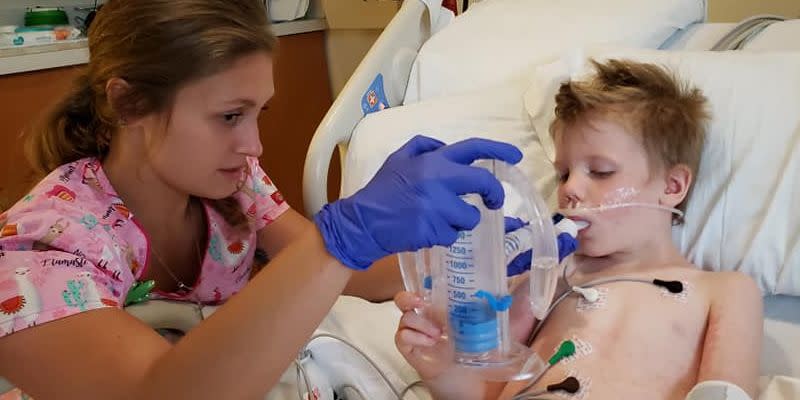Mother’s Warning Goes Viral After Her Young Son Nearly Drowned In A Pool Full Of Adults

Indiana mother of five, Maribeth Leeson, shared a Facebook post about her son’s near-drowning experience in the hopes of preventing future deaths.
Leeson’s five-year-old son Adam was in a pool full of adults and looked to be playing, yet he was silently drowning and barely escaped death after being rushed to the hospital.
The CDC says that 1 in 5 people who die from drowning are children 14 and younger, but it can be prevented with a few simple tips.
Every parent’s worst fear is losing their child, and for Indiana mom Maribeth Leeson, this became dangerously close to her reality after a family trip to the pool. “I saw my dead baby on the ground,” Leeson wrote in a Facebook post this week. “His limp, gray, lifeless body was pulled from the pool and it was every mother’s worst nightmare.”
Leeson didn’t think too much of letting her five-year-old son Adam head over to the shallow end of their local pool as she helped his three-year-old sister get her swimsuit on. However, Adam later revealed that he had accidentally slipped into the deep end, and “kept going to the bottom then to the top and tried to yell ‘Mommy!’” as he struggled to swim. He couldn’t make it to the top.
“I heard screaming, and after a minute realized the screaming was coming from me. I watched in slow motion as people rushed to him, as he was laid on the concrete, as CPR was started,” Leeson recalled, as she caught a glimpse of her 10-year-old son sobbing as he watched his brother drown.
Drowning is a leading cause of unintentional death for children ages 1 to 4, according to the Centers for Disease Control and Prevention (CDC), only second to birth defects. Adam almost became part of that statistic, but then, a miracle happened.
“After what felt like an eternity, Adam opened his eyes. He had a pulse,” Leeson wrote. “A million thoughts continued racing through my mind. I was sure even if he was saved, it was too late. I was sure machines were going to be doing the living for him.”
Adam was rushed to the hospital, and after just three days in the Pediatric Intensive Care Unit at Peyton Manning Children’s Hospital in Indianapolis, he was breathing on his own and able to return home to his family.
Leeson is sharing her story in the hopes that parents will learn from her experience. “I’ve never considered the possibility that my child could drown right in front of people who were watching him bob up and down from the bottom of the pool to just below the surface, but didn’t think he was struggling because he looked like he was PLAYING,” she wrote. “This was 100% preventable. I thought it was fine for 5 minutes, as he could touch just fine in the shallow end, he wasn’t alone because there were multiple adults IN the pool, and I’d be right next to the pool getting her suit on. Wrong. I have never ever been so wrong.”
Drowning is the third leading cause of unintentional injury-related deaths worldwide, and the World Health Organization says that children between the ages of one and nine are most at risk. However, there are many ways to prevention drowning, so your family can safely enjoy their time at the pool.
“Before going to any pool, first make sure your kids know not to get in until the adult who is responsible for them is ready to watch them,” Leeson advises. “That sounds like common sense, but I was thinking because so many adults were present, he was fine, but those adults didn’t know his swimming ability so they didn’t question when he was under water.”
Leeson also noted that drowning also doesn’t always involve screaming, splashing, or thrashing, which is why other adults didn’t realize Adam was drowning. The CDC recommends implementing “touch supervision,” meaning that you should always be close enough to reach your children at all times when they’re swimming. Young children should also have lifejackets—not a floaty, noodle, or similar air-filled device—especially if they do not know how to swim.
Leeson also stressed the importance of knowing cardiopulmonary resuscitation (CPR), which the CDC says improves the outcome in drowning situations and can ultimately save someone’s life—especially if done immediately. “I do know CPR. Could I have performed it in that moment? I like to believe I could have if I hadn’t seen someone else taking charge,” Leeson wrote. “Luckily, I don’t know because my amazing friend was busy saving him, but I do know that if I didn’t know CPR, my helping him if we’d been alone wouldn’t have even been a possibility.”
It’s also important to sign your children up for formal swim lessons if you expect to take family vacations or trips that involve pools and bodies of water. New guidelines from the American Academy of Pediatrics (AAP) say that babies can begin swimming lessons at just one year old. The AAP also says that “children ages 1 to 4 may be less likely to drown if they have had formal swimming instruction.”
Leeson’s friend, Katie Finley Johnson, has created a GoFundMe page to help the Leeson family pay for Adam’s medical bills, as the family doesn’t have medical insurance. They are close to hitting their goal. To support the Leeson family and help Adam recover, donate to their GoFundMe page here.
You Might Also Like

